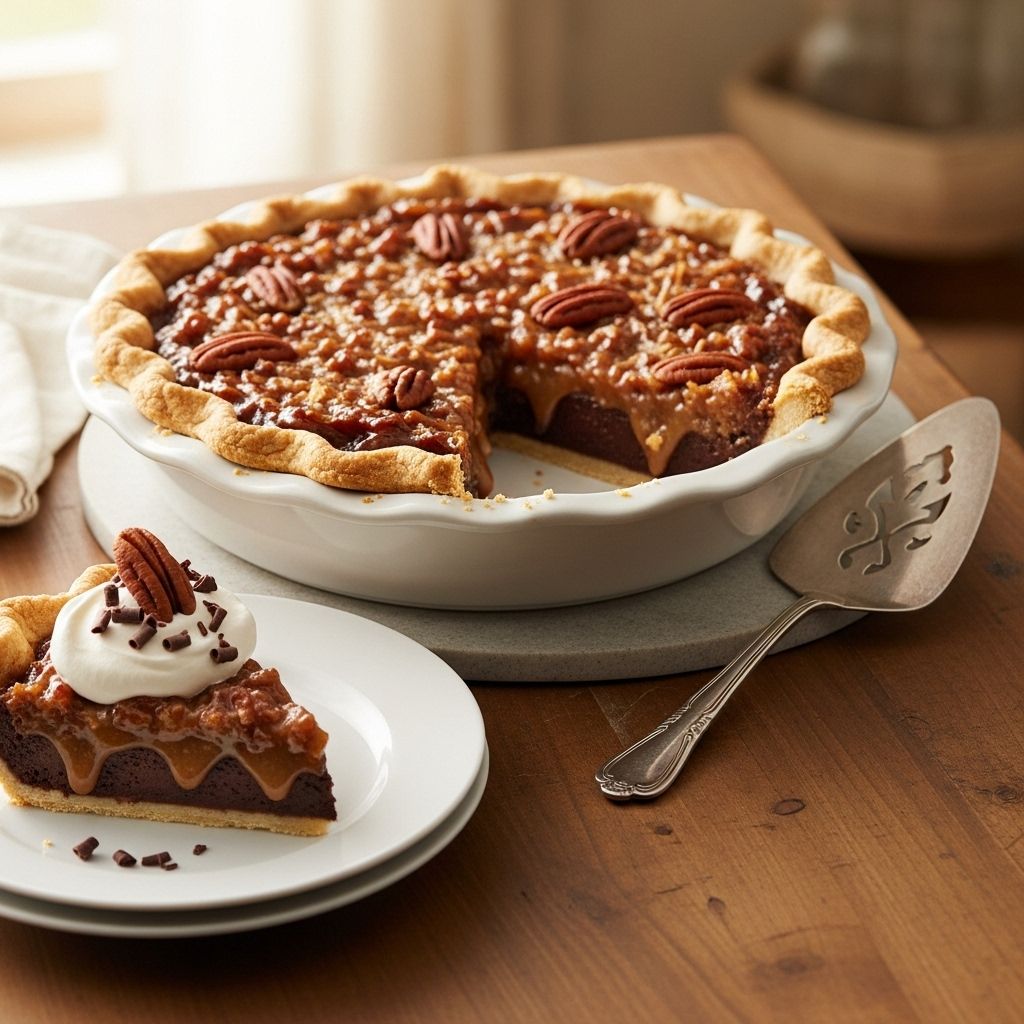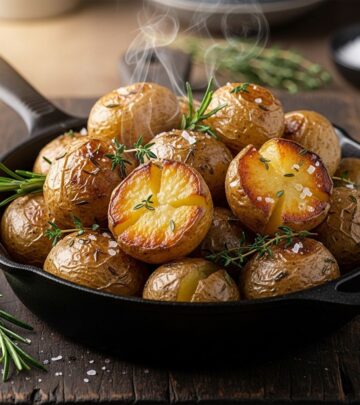German Chocolate Pie Recipe – Easy Dessert Guide
A perfect balance of creamy filling, crunchy pecans, and sweet coconut in every bite.

German chocolate pie brings together all the beloved flavors of the classic layered cake—rich chocolate, crunchy pecans, and sweet coconut—in a much simpler format that’s perfect for any occasion. This decadent dessert combines the complexity of German chocolate cake with the ease of pie-making, creating a show-stopping treat that requires less effort than its multi-layered cousin.
When German chocolate cake is good, it’s absolutely divine. The interplay between rich chocolate, chopped pecans, and shredded coconut creates a flavor combination that’s hard to beat. However, making the traditional cake involves multiple steps: baking the cake layers, preparing the filling, and creating the frosting. German chocolate pie simplifies this process dramatically while maintaining all those incredible flavors we love.
What Makes German Chocolate Pie Special
German chocolate pie stands out from other chocolate desserts because it combines multiple textures and flavors in every bite. Unlike traditional chocolate pies that focus solely on chocolate flavor, this version incorporates the signature coconut and pecan combination that makes German chocolate cake so memorable. The filling has a custard-like consistency that’s rich and satisfying, while the nuts and coconut add delightful texture contrasts.
The beauty of this dessert lies in its simplicity. Instead of managing multiple components like cake layers and separate frosting, everything comes together in one filling that bakes directly in the pie crust. This makes it an excellent choice for holiday entertaining, potluck dinners, or any time you want an impressive dessert without the complexity.
Essential Ingredients for Perfect German Chocolate Pie
The success of German chocolate pie depends on using quality ingredients that complement each other perfectly. Here’s what you’ll need to create this indulgent dessert:
The Foundation
A proper pastry crust forms the base of this pie. While you can certainly use a store-bought frozen or refrigerated pie crust for convenience, a homemade pastry crust will provide superior flavor and texture. Avoid graham cracker crusts for this recipe, as they won’t provide the structural support needed for the rich filling.
Chocolate Components
Semisweet chocolate chips serve dual purposes in this recipe—they’re melted with butter to create the chocolate base, and additional chips are folded into the filling for bursts of chocolate throughout each slice. The combination creates both smooth chocolate flavor and textural interest.
Binding Ingredients
Sweetened condensed milk acts as both a sweetener and binding agent, creating the custard-like consistency that sets beautifully during baking. Fresh eggs provide structure and richness, while vanilla extract enhances all the other flavors in the pie.
Signature Mix-ins
Chopped pecans and unsweetened shredded coconut are what transform this from a simple chocolate pie into authentic German chocolate pie. These ingredients should be evenly distributed throughout the filling to ensure every slice contains the perfect balance of flavors.
Step-by-Step Preparation Guide
Preparing Your Workspace
Begin by preheating your oven to 350°F and lining a rimmed baking sheet with foil. This preparation step is crucial for even baking and easy cleanup. If you’re working with frozen pie crust, allow it to thaw slightly while you prepare the other components.
Creating the Perfect Crust
On a well-floured surface, roll out your pie dough into a 12-inch circle, working from the center outward. This technique ensures even thickness throughout the crust. If the dough becomes too sticky, don’t hesitate to add more flour to prevent sticking.
Carefully transfer the rolled dough to your 9-inch pie pan, gently pressing it against the sides without stretching. Tuck any overhanging dough underneath itself and crimp the edges with your fingers to create an attractive border that will hold the filling securely.
Preparing the Chocolate Base
The chocolate component requires careful attention to prevent burning or seizing. Place chocolate chips and butter in a microwave-safe bowl and heat at 50 percent power in 30-second intervals. Stir between each interval until the mixture is completely smooth and glossy. This gradual melting process ensures a silky texture without any grainy bits.
Combining the Filling
Once your chocolate mixture has cooled slightly, scrape it into a large mixing bowl. Add the eggs one at a time, whisking thoroughly after each addition to prevent the eggs from cooking due to residual heat. The sweetened condensed milk, salt, and vanilla should be incorporated next, creating a smooth, custard-like base.
Finally, fold in the chopped pecans and shredded coconut using a gentle stirring motion to distribute them evenly without deflating the mixture. The pecans should be roughly chopped to provide substantial pieces in each bite, while the coconut should be unsweetened to balance the overall sweetness.
Baking Techniques for Best Results
Proper Baking Setup
Pour the prepared filling into your unbaked pie crust, ensuring even distribution. Place the filled pie on the prepared baking sheet before putting it in the oven. The baking sheet serves multiple purposes: it catches any potential spills, provides more even heat distribution, and makes it easier to remove the hot pie from the oven safely.
Recognizing Doneness
German chocolate pie requires careful timing to achieve the perfect texture. The filling won’t set completely in the oven—this is normal and expected. Look for these visual cues: the top should puff slightly, and while the edges should appear set, the center should still have a slight jiggle when gently shaken.
Typically, baking takes 35 to 40 minutes, but oven variations mean you should rely on visual cues rather than timing alone. Overbaking will result in a dense, dry texture, while underbaking may prevent proper setting even after cooling.
Cooling and Storage Guidelines
Essential Cooling Process
Patience is crucial when it comes to German chocolate pie. After removing it from the oven, transfer the pie to a wire cooling rack and allow it to cool completely—this takes approximately 2 hours at room temperature. The filling continues to set during this cooling period, achieving its final custard-like consistency.
Refrigeration Requirements
Since German chocolate pie contains eggs and dairy products, it must be refrigerated after cooling. This is not optional—it’s a food safety requirement. Wrap the cooled pie loosely in plastic wrap and refrigerate for at least 4 hours before serving, though overnight chilling produces the best texture.
Storage Tips
Properly stored German chocolate pie will keep in the refrigerator for up to one week. For individual servings, you can slice the pie and wrap pieces separately. If you need to freeze the pie, wrap it tightly in plastic wrap followed by aluminum foil, and it will maintain quality for up to three months.
Serving Suggestions and Variations
Classic Presentation
German chocolate pie is delicious on its own, but thoughtful garnishes can elevate the presentation. Traditional toppings include a dollop of freshly whipped cream, additional chopped pecans, and toasted coconut flakes. A light dusting of cocoa powder or chocolate shavings adds visual appeal and extra chocolate flavor.
Creative Variations
While the classic recipe is perfection, you can customize it to suit different preferences. Try substituting walnuts for pecans, using dark chocolate chips instead of semisweet, or adding a tablespoon of bourbon or rum extract for adult flavor complexity. Some bakers enjoy adding a layer of caramel sauce between the crust and filling.
Troubleshooting Common Issues
Preventing Soggy Crusts
If you’re concerned about a soggy bottom crust, try blind-baking the crust for 10 minutes before adding the filling. This creates a barrier that helps maintain crust integrity. However, with proper baking temperature and timing, this usually isn’t necessary.
Achieving Perfect Texture
The key to perfect German chocolate pie texture lies in not overbaking. The filling should still have a slight jiggle in the center when removed from the oven. Remember that it continues cooking from residual heat and sets completely during the cooling process.
Frequently Asked Questions
Q: Can I make German chocolate pie ahead of time?
A: Yes, German chocolate pie is actually better when made a day ahead. The flavors have time to meld together, and the texture becomes perfectly set. Just cover and refrigerate until ready to serve.
Q: Why is my German chocolate pie filling runny?
A: Runny filling usually indicates underbaking or not allowing enough cooling time. The pie needs to cool completely at room temperature, then be refrigerated for several hours to achieve proper consistency.
Q: Can I use a different type of chocolate?
A: While semisweet chocolate chips work best, you can experiment with dark chocolate for a more intense flavor or milk chocolate for a sweeter result. Avoid white chocolate as it won’t provide the authentic German chocolate flavor.
Q: What’s the difference between German chocolate pie and regular chocolate pie?
A: German chocolate pie includes coconut and pecans mixed directly into the filling, while regular chocolate pie typically focuses only on chocolate flavor. The coconut and nuts are what make it distinctly “German chocolate” style.
Q: How do I prevent the nuts from sinking to the bottom?
A: Lightly coating the nuts and coconut in a small amount of flour before folding them into the filling helps prevent sinking. Also, don’t overmix the filling once the nuts are added.
German chocolate pie represents the perfect marriage of convenience and indulgence. It captures all the beloved flavors of German chocolate cake in a format that’s accessible to bakers of all skill levels. Whether you’re preparing for a holiday gathering or simply craving that perfect combination of chocolate, coconut, and pecans, this pie delivers satisfaction in every bite. The rich, custard-like filling paired with crunchy nuts and chewy coconut creates a dessert experience that’s both familiar and special—exactly what you want from a homemade pie.
References
- https://www.favfamilyrecipes.com/german-chocolate-pie/
- https://www.thepioneerwoman.com/food-cooking/recipes/a37762734/german-chocolate-pie-recipe/
- https://www.thepioneerwoman.com/food-cooking/recipes/a42388162/german-chocolate-cake-recipe/
- https://www.thepioneerwoman.com/food-cooking/recipes/a11850/chocolate-pie/
Read full bio of medha deb












